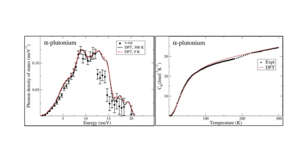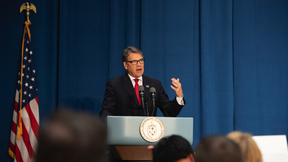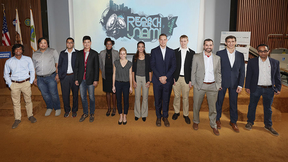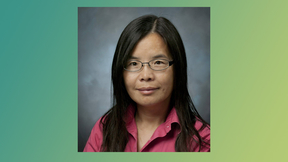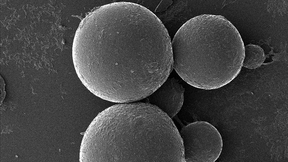Back
Physical and Life Sciences
LLNL discovers new method to create nanocarbons
Nanocarbons have emerged as major nanomaterials due to their many practical applications, including their potential use in energy conversion/storage, bioimaging, drug delivery, sensors, diagnostics and composites. However, their synthesis remains poorly understood. A common high-pressure synthesis route is the detonation of carbon-rich high explosives, which yields…
Developing a machine learning framework for accelerated material discovery
Driven by the success of machine learning (ML) in commercial applications such as product recommendations and advertising, researchers are attempting to apply ML tools to scientific data analyzation. One such application area is materials science, where ML methods could accelerate the selection, development, and discovery of materials by learning structure–property…
Important plutonium property calculated for the first time
Lattice vibrations (phonons) are important for all equation-of-state modeling. A recent paper by PLS researchers Per Söderlind and Lin Yang (both PHYS) describes results from the first-ever calculation of α-plutonium phonon density of states. The first-principles model agrees very well with the results of x-ray scattering experiments. Further, the calculated specific heat…
Ancient stardust leads to clearer picture of solar system
Interstellar dust is an important component of our galaxy. Condensed in the outflow of dying stars, it is used to study stellar evolution, nucleosynthesis and the chemical development of the galaxy. Although dust only presents about 1 percent of the mass in the interstellar medium (ISM), it carries a large fraction of the elements heavier than helium, including the…
Lab teams recognized by Secretary of Energy awards
Former Secretary of Energy Rick Perry recognized Lawrence Livermore National Laboratory (LLNL) staff with six Secretary’s Honor Awards at a ceremony at Department of Energy (DOE) headquarters. The Secretary’s Honor Awards are bestowed on teams that have achieved a singular accomplishment that demonstrates a high level of performance and dedication to public service. As his…
Under pressure: Using NIF, researchers compress copper, creating the densest object on Earth
If copper was found in the core of Saturn it would have the same crystalline structure as the copper pipes found in many homes, according to new research from Lawrence Livermore National Laboratory (LLNL) and Johns Hopkins University. In a paper published today by Physical Review Letters, the research team reveals that copper maintains its crystalline structure at…
Lab space program lifts off with launch of satellite
Lawrence Livermore National Laboratory’s (LLNL's) Space Science and Security Program had a banner month in December as the program sent the Lab’s first in-house designed and fabricated CubeSat into orbit. The Lab satellite was sent into orbit from Space Launch Complex 40 at Cape Canaveral Air Force Station in Florida on Dec. 5 aboard a SpaceX Dragon capsule atop a two…
Thanks to clouds, latest climate models predict more global warming than their predecessors
Researchers at Lawrence Livermore National Laboratory (LLNL) in collaboration with colleagues from the University of Leeds and Imperial College London have found that the latest generation of global climate models predict more warming in response to increasing carbon dioxide than their predecessors. These refined models represent aspects of Earth’s climate better than…
STAR array tests materials’ response to strong X-ray shocks
At first glance it might be mistaken for a model of the Millennium Falcon of “Star Wars” fame. But it’s actually a new radiation-effects diagnostic that triples the number of material samples that can be exposed to X-rays in a single NIF shot. Designed by researchers from Lawrence Livermore National Laboratory (LLNL) and Sandia National Laboratories, the STAR (Sample Test…
PLS postdocs shine at Research Slam! competition
On October 29, 2019, twelve Lawrence Livermore postdocs took to the stage, each with three slides and three minutes to answer the question: “Why is your research important?” The presentations, part of a yearly competition known as the Research Slam!, were a culmination of months of development, training, and practice. The 2019 program kicked off with seminars about…
Three researchers co-author wind power papers
A trio of Livermore scientists have served as co-authors for three separate papers about projects they’ve worked on to upgrade wind power forecasting for the nation. The papers, published by the Bulletin of the American Meteorological Society (BAMS), one of the premier publications for meteorologists, focused on research conducted for two high-impact Department of Energy…
Scientists image deformation of copper at the nanoscale
Lawrence Livermore National Laboratory (LLNL) researchers, in collaboration with Johns Hopkins University and the U.S. Army Research Laboratory, have successfully obtained the first nanoscale video of copper deforming under extremely high strain rates, part of an Army-funded project aimed at designing next-generation armor. Combining a specially designed straining…
Mimicking the blood-brain barrier on chip-based device
Engineers and biologists at Lawrence Livermore National Laboratory (LLNL) have made significant strides in modeling the human brain outside the body on a chip, but to truly recreate the effects of drugs or chemical agents on the central nervous system, researchers will need to accurately simulate the blood-brain barrier (BBB). Normally the BBB, the vasculature that…
Understanding the spread and mutation of Zika virus
A team of Lawrence Livermore National Laboratory (LLNL) and University of California, Davis researchers has found that outbreaks of human disease, such as the 2015 Zika virus epidemic, may be due to genetic mutation, and viruses may undergo further changes as they expand their geographic range. The question of how Zika virus (ZIKV) changed from a seemingly mild virus to a…
Nuclear melt glass-derived colloid experiments explain why plutonium is migrating in groundwater
The migration of low levels of plutonium has been observed at the Nevada National Security Site (NNSS) and attributed to colloid-facilitated transport. (A colloid is a mixture in which one substance of microscopically dispersed particles is suspended throughout another substance.) To understand why plutonium is migrating, LLNL scientists performed experiments using mineral…
Meteorites lend clues to solar system's origin
The isotopic composition of meteorites and terrestrial planets holds important clues about the earliest history of the solar system and the processes of planet formation. Lawrence Livermore National Laboratory (LLNL) scientists and a collaborator from the University of Münster reviewed recent work that shows how meteorites exhibit a fundamental isotopic dichotomy between…
Researchers uncover viral predators in soil
Viruses impact nearly all organisms on Earth, with waves of influence in agriculture, health and biogeochemical processes. However, very little is known about RNA viruses in the environment, and even less is known about their diversity and ecology in soil, one of the most complex microbial systems. But Lawrence Livermore National Laboratory (LLNL) scientists have helped…
Center Collaborates with UC San Diego to Deliver Plasma Diagnostics Course
LLNL’s HED Science Center is collaborating with the University of California (UC) San Diego, to offer a graduate-level course in diagnostics for HED plasmas. The 10-week online course will begin on March 31, 2020 and will be co-taught by two HED science experts from LLNL. HED plasma physics is a growing field, with many major laser and pulsed-power facilities around the…
LLNL researchers turn to microbe beads to increase U.S. supply of rare earth metals
To help increase the U.S. supply of rare earth elements, a Critical Materials Institute team led by Lawrence Livermore National Laboratory (LLNL) is using microbe beads to recover rare earth elements from consumer electronic waste. The team developed a scalable biosorbent material – a microbe-embedded polymer – by combining material science with microbiology. The research…
Lawrence Livermore steps into grid modernization
Lawrence Livermore National Laboratory (LLNL) will receive funding from the Department of Energy (DOE) over the next three years to strengthen, transform and improve the nation’s energy infrastructure. LLNL is the lead on three projects: Using sensors to identify faulty or aging components of the nation’s energy grid system In its first stage, this application will…




